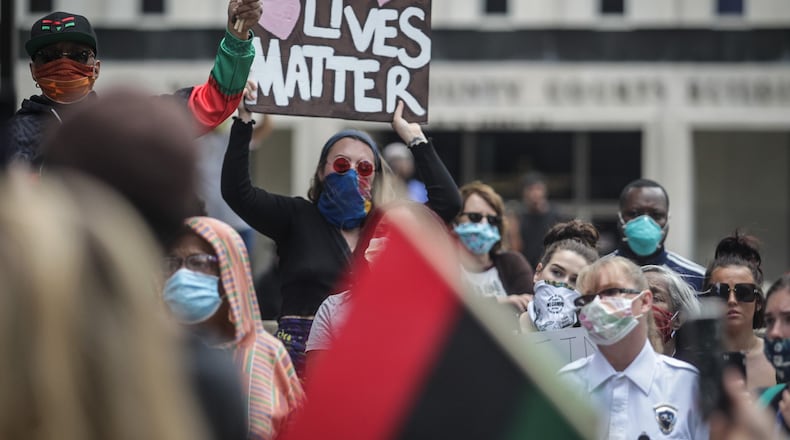“The risk of contracting COVID-19 is still very much present, and we should be mindfully protesting. The point is to make a statement, but you’re also trying to stay healthy,” said Dr. Mamle Anim, chief medical officer at Dayton-based Five Rivers Health Centers.
A challenge is that African Americans who are already disproportionately getting sick from COVID-19 could be at additional risk from the large crowds at the racial injustice protests that started in cities across the U.S. after George Floyd was killed.
CORONAVIRUS: Complete coverage
“It’s difficult because its very emotional, but we have to be smart about it, otherwise we’re going to see a spike, and that’s the last thing we need right now,” Anim said.
This is a defining moment in the Black Lives Matter movement, and it’s understandable to want to support the cause, she said. However, if an individual has added risk factors such as diabetes, hypertension, obesity and a depressed immune system, it’s more likely for them to get infected with the COVID-19. Anim said it’s important to wear a mask, practice good hand hygiene, be mindful of who you are next to in a crowd and work to stay spaced apart. Another option is to protest virtually on social media and other online platforms, or put up signs to show support, she said.
African Americans are facing two pandemics — the COVID-19 and police brutality — so people should not make one issue overshadow the other when both have risks, she said.
“Both of them are mortality risks,” Anim said. “Police brutality is a mortality risk. The COVID-19 is a mortality risk. We don’t say, ‘Stroke versus heart attack, let’s pick one over the other.’ They are both important and should be addressed.”
Columbus Public Health said Wednesday that it is aware of a person with a confirmed case of the COVID-19. The individual was symptomatic May 27 and attended the protests in downtown Columbus. The department urged protesters to help protect themselves and others by wearing a face covering, avoiding large crowds and staying home if sick.
“We are fighting racism during an unprecedented global pandemic,” Dr. Mysheika Roberts, health commissioner for the city of Columbus said in a statement. “Racial disparities in public health exist across the country, and right here in our community. Let’s not unintentionally spread COVID-19 through peaceful protests. Stay safe and wear a face covering.”
The U.S. has had more than 105,000 deaths from the outbreak.
MORE: Companies cut or suspend ties with local CEO over social media comment
In Ohio, there have been 2,135 confirmed deaths since the start of the outbreak, and 2,355 deaths when including confirmed and probable deaths. There were 671 people admitted to Ohio hospitals from COVID-19 as of Friday, with 259 in the ICU and 168 on a ventilator.
Of the total cases in Ohio, 31% have been black, although the state’s African American population is about 14%.
Donald Domineck, the chair of the New Black Panthers Party, said when his organization helped organize Saturday’s protests in downtown Dayton, they emphasized that people wear masks.
He said he thinks people are so angry about Floyd’s murder that they are forgetting to practice social distancing, and that’s incentive for government officials to bring about a rapid end to police killing black folks.
“We got ourselves in this situation in America,” he said. “We have a situation where we need to keep people apart, but they are so upset with what happened they said, ‘To hell with those rules,’ and we’re going to protest any way.”
Experts point out that other factors associated with current protests could accelerate the spread of the virus. For instance, tear gas can cause people to cough and sneeze, and remove masks. Crowding protesters who have been arrested and put in jail cells can also increase the risk of contagion.
The unrest is happening in tandem with the reopening of gyms, hair salons, restaurants, parks and beaches. It also came on the heels of the Memorial Day weekend, when many people attended large gatherings, so experts already were bracing for a case increase, said Jennifer Nuzzo, an epidemiologist at Johns Hopkins University.
Oregon District businesses: White supremacists terrorized Saturday night
“The absolute number of cases is still high. We feel good about the fact that we’ve established a decreasing incidence, but we have a ways to go,” said Dr. Ronald Hershow, director of the Division of Epidemiology and Biostatistics at the University of Illinois-Chicago.
Hershow and others noted that the racial disparities laid bare by coronavirus — with communities of color bearing a disproportionate burden of infections and deaths — overlap with the issues being protested on streets across America and around the globe.
“Racism kills,” Hershow said. “Sometimes that’s direct, as in the case of George Floyd. And sometimes it’s through a virus like COVID-19.”
Associated Press contributed to this report.
About the Author
